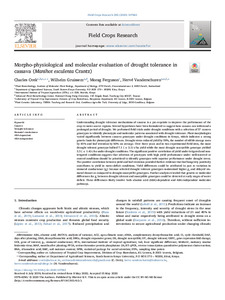| dc.contributor.author | Orek, C. |
| dc.contributor.author | Gruissem, W. |
| dc.contributor.author | Ferguson, M. |
| dc.contributor.author | Vanderschuren, H. |
| dc.date.accessioned | 2022-01-18T08:59:54Z |
| dc.date.available | 2022-01-18T08:59:54Z |
| dc.date.issued | 2020-09-15 |
| dc.identifier.citation | Orek, C., Gruissem, W., Ferguson, M. & Vanderschuren, H. (2020). Morpho-physiological and molecular evaluation of drought tolerance in cassava (Manihot esculenta Crantz). Field Crops Research, 255, 107861: 1-13. |
| dc.identifier.issn | 0378-4290 |
| dc.identifier.uri | https://hdl.handle.net/20.500.12478/7312 |
| dc.description.abstract | Understanding drought tolerance mechanisms of cassava is a pre-requisite to improve the performance of the crop in water-scarce regions. Several hypotheses have been formulated to suggest how cassava can withstand a prolonged period of drought. We performed field trials under drought conditions with a selection of 37 cassava genotypes to identify phenotypic and molecular patterns associated with drought tolerance. Plant morphologies varied significantly between cassava genotypes under drought conditions in Kenya, which indicates a strong genetic basis for phenotypic differences. Drought stress reduced yield by 59%, the number of edible storage roots by 43% and leaf retention by 50% on average. Over three years and in two experimental field sites, the most drought tolerant genotype bulked 7.1 (±2.1) t/ha yield while the most drought susceptible genotype yielded 3.3 (±1.4) t/ha under drought conditions. The significant positive correlation of yield under irrigated and non-irrigated conditions suggests that selection of genotypes with high yield performance under well-watered or control conditions should be prioritized to identify genotypes with superior performance under drought stress. The positive correlation between yield and leaf retention provided further evidence that leaf longevity positively contributes to yield in water-deficit conditions. Yield differences could be attributed in part to variation in stomatal conductance (gs) because selected drought tolerant genotypes maintained higher gs and delayed stomatal closure as compared to drought susceptible genotypes. Further analysis revealed that genetic or molecular differences for gs between drought tolerant and susceptible genotypes could be detected at early stages of water deficit. These differences likely involve both abscisic acid (ABA)-dependent and ABA-independent molecular pathways. |
| dc.format.extent | 1-13 |
| dc.language.iso | en |
| dc.subject | Cassava |
| dc.subject | Drought Tolerance |
| dc.subject | Genotypes |
| dc.subject | Yields |
| dc.title | Morpho-physiological and molecular evaluation of drought tolerance in cassava (Manihot esculenta Crantz) |
| dc.type | Journal Article |
| cg.contributor.crp | Roots, Tubers and Bananas |
| cg.contributor.affiliation | ETH Zurich |
| cg.contributor.affiliation | International Institute of Tropical Agriculture |
| cg.contributor.affiliation | National Chung Hsing University |
| cg.contributor.affiliation | Katholieke Universiteit, Leuven |
| cg.contributor.affiliation | University of Liège |
| cg.coverage.region | Africa |
| cg.coverage.region | East Africa |
| cg.coverage.country | Kenya |
| cg.coverage.hub | Eastern Africa Hub |
| cg.researchtheme | Biotech and Plant Breeding |
| cg.identifier.bibtexciteid | OREK:2020 |
| cg.isijournal | ISI Journal |
| cg.authorship.types | CGIAR and advanced research institute |
| cg.iitasubject | Agronomy |
| cg.iitasubject | Cassava |
| cg.iitasubject | Plant Breeding |
| cg.iitasubject | Plant Diseases |
| cg.iitasubject | Plant Production |
| cg.journal | Field Crops Research |
| cg.notes | Open Access Article; Published online: 28 Jun 2020 |
| cg.accessibilitystatus | Open Access |
| cg.reviewstatus | Peer Review |
| cg.usagerightslicense | Creative Commons Attribution 4.0 (CC BY 0.0) |
| cg.targetaudience | Scientists |
| cg.identifier.doi | https://dx.doi.org/10.1016/j.fcr.2020.107861 |
| cg.iitaauthor.identifier | Morag Ferguson: 0000-0002-7763-5173 |
| cg.futureupdate.required | No |
| cg.identifier.issue | 107861 |
| cg.identifier.volume | 255 |

